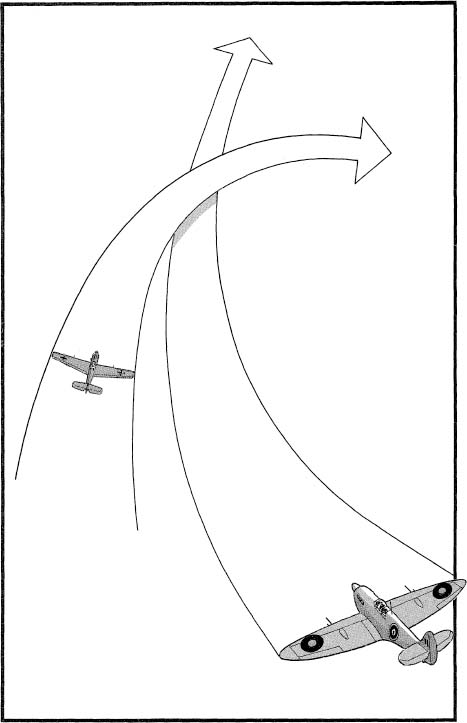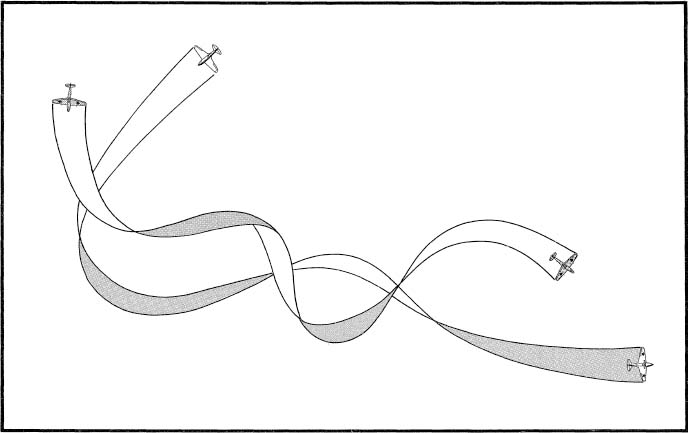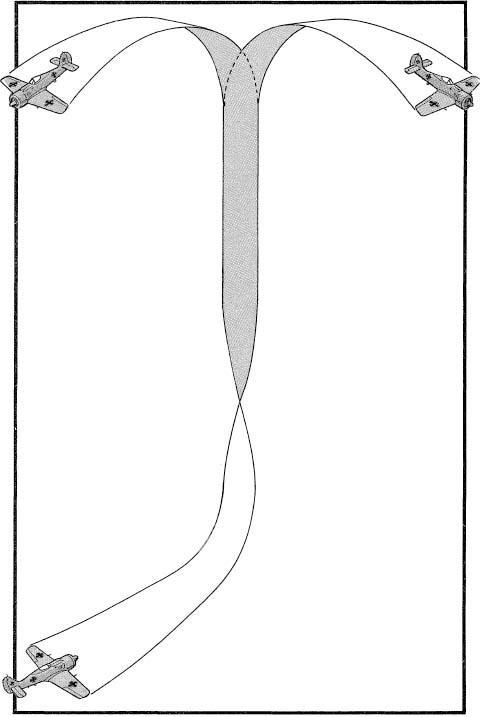Luftwaffe Fighter Aces (3 page)
Read Luftwaffe Fighter Aces Online
Authors: Mike Spick

In common with most other air forces of the period, the German fighter pilots were taught standard manoeuvres for fighter-versus-fighter combat. Aerobatics played little or no part in these; in the main they involved hard turning to get on the tail of an opponent. But while turning ability was important to a fighter, it was not an absolute. Both radius and rate of turn are functions of speed: as the speed increases, so the radius of turn widens, while the rate of turn, measured in degrees per second, decreases (see
Fig. 1
). All else being equal (which it seldom is) the slower aircraft will generally out-turn the faster.
Attacks were generally launched from a higher altitude, often from the glare of the sun. Mostly these took the form of a curve of pursuit which brought the attacker in behind his opponent. If the attacker remained unseen and his shooting was accurate, a victory was very probable. If, however, the attacker was seen coming in, his opponent took evasive action and the fight was on. The basic evasion manoeuvre was the break (
Fig. 2
). In this, the defending aircraft turned as hard as possible in the direction of the attacker, who only rarely would be dead astern. This rapidly increased the deflection angle, giving the attacker the most difficult shot possible. If the turn capabilities of the two aircraft were fairly similar, and the speed difference was not too great, they would then enter the classic turning fight, with each trying to out turn the other to achieve a firing position. As hard turning bled off speed, the circles turned into a downward spiral. This ended only when another aircraft intervened, or the lower one was forced to pull out by the proximity of the ground.

Fig. 2.
The Break
The standard procedure when attacked from astern was to turn as hard as possible in the direction of the attacker. This gave a difficult crossing shot, and if the attacker had a speed advantage it frequently caused him to overshoot.
As the attacker was often moving considerably faster than his opponent in order to close the range quickly, he would frequently be unable to hold his position on the inside of the turn and would overshoot to the outside. This gave the defender a chance to turn the tables by reversing the direction of his turn back towards his opponent. At this point the original attacker could reverse his own turn. A series of turn reversals then ensued, known as the scissors (
Fig. 3
), in which both aircraft tried to gain a position astern, with the advantage going to the most manoeuvrable. In the scissors, a faster rate of roll was often a greater advantage than turning ability, as it allowed changes of direction to be made very quickly.
Once the attacker overshot, he had two alternatives to entering a scissors, both using his speed advantage: he could dive away out of range, or he could pull up, converting his excess speed into altitude. An aileron turn in the vertical climb allowed him to reposition himself, pulling out into level flight in any direction he chose, ready for another diving attack. The modern name for this is the Immelmann Turn (see
Fig. 4
). Alternatively he could stall-turn at the top of his climb and launch into another diving attack. These were the tricks on which all fighter combat was based.
Legion Kondor
Preparation and training for war is a largely theoretical exercise. The trouble is that training is carried out in a sterile environment: rarely does anyone get killed, and then only by accident. Until the shooting starts, no one knows for certain what will happen, how either aircraft or individuals will perform, and what unforeseen problems lie in wait. In this respect the
Luftwaffe
was lucky: a civil war broke out more or less on Germany’s doorstep which it was able to use as a proving ground for new ideas and theories.

Fig. 3. The Scissors
Once the break forced an attacker to overshoot, a series of turn reversals, known as the scissors, could force the attacker out in front. Not recommended against a better-turning aircraft.
The Spanish Civil War, which commenced in 1936, was a conflict between the Nationalists, who were thinly disguised Fascists, and the Republicans, who were less thinly disguised Communists. Hitler, who was inherently opposed to Bolshevism, naturally sided with the Nationalists and provided aid. In this he was not alone: Benito Mussolini sent a strong Italian contingent. To provide some balance, Stalin furnished a considerable amount of Soviet aid to the Republicans. Three nations thus stood to benefit from battle experience in Spain. However, circumstances conspired to see that, in the field of fighter tactics, the only real gains were those made by the
Luftwaffe.
To maintain the fiction of legality, the Germans were all ‘volunteers’ and arrived in Spain as ‘tourists’ on a succession of cruise ships. The first German fighters to arrive were Heinkel He 51 biplanes. These were handed over to the Spanish, who achieved little, a state of affairs which led to German instructors taking over and flying operationally. All aircraft bore Spanish Nationalist insignia, a practice which continued even when the
Legion Kondor
expanded into a full-scale miniature air force with its own fighter, bomber and reconnaissance units.
Air combat was at first very similar to that of the First World War, with fighters flying in the
Kette,
a formation of three aircraft in either tight ‘Vic’ or echelon. Standard tactics consisted of a diving attack from the direction of the sun, after which the battle degenerated into a series of individual turning fights.
Initially all went well for the Nationalists, who were opposed by an international ragbag of volunteers flying a variety of antiquated aircraft. Matters changed in October 1936 with the arrival of a large Soviet contingent equipped with Polikarpov I-15 and I-16 fighters and Tupolev SB-2 bombers, to aid the hard-pressed Republicans. At that time the I-16 was the most modern fighter in service anywhere in the world. By using dive and zoom tactics the Russian monoplane could more than hold its own against the agile Italian Fiat CR.32s, and it totally outclassed the German He 51s. The I-15 was a biplane of superior all-round performance to the German fighter, while the SB-2 bomber was too fast to be easily caught by the Heinkel biplane.
The balance was partially redressed in the spring with the arrival of the first Bf 109Bs. These were assigned to the
2nd Staffel
of
Jagdgruppe 88,
commanded by Günther Lützow. Powered by a Junkers Jumo 210D or E engine, and armed with three MG 17 7.9mm machine guns, the 109B was nowhere near as potent as the models that were to follow, but in many ways it was a better fighting machine than the I-16. It was at this point that a quirk of fate determined the course of
Legion Kondor,
and eventually
Luftwaffe,
fighter tactics. The initial delivery was a mere six aircraft, and further deliveries were slow in arriving. This, coupled with the fact that the operational début of any new fighter is beset with serviceability and maintenance problems, kept the number of available 109s low for some considerable time. Lützow and his fellow
Staffelkapitän,
Joachim Schlichting of
1/J 88,
were forced to improvise.

Fig. 4. The Immelmann Turn
Named after First World War ace Max Immelmann, this manoeuvre allows a fighter to reposition without too much horizontal displacement. The fighter pulls up vertically, aileron turns in the desired direction, then pulls out and rolls upright.
Forming three-aircraft
Ketten
from the number of aircraft available was difficult, and often wasteful of resources. Four serviceable aircraft allowed a
Kette
of three and one spare. A more convenient solution was to use the two-aircraft
Rotte,
with two
Rotte
making up a
Schwarm.
In action it was found that the pair gave far more operational flexibility than a three-ship. Air-to-air radio was another advantage: with less need to rely on visual signals, spacings could become wider. Trial and error showed the optimum distance between aircraft to be about 600ft in line abreast. By concentrating his search inwards, each pilot could cover the blind spots below and behind his fellow. Teamwork was made easy. If one aircraft of a pair was bounced from astern and broke into the attack, his
Kacmarek
(wingman: an old Silesian family name) turned in the same direction. If the attacker followed his target around the break, he soon found the wingman on his tail, sandwiching him (see
Fig. 5
). If the leader launched an attack, his wingman was well placed to drop back and cover him, thus allowing the leader to concentrate entirely on attack, knowing that he would be warned if danger threatened.
The He 51s remained in service with
3/J 88
in the ground attack role until April 1938, when they were replaced by the Bf 109C, which mounted four MG 17s but was in other respects much the same as the B model. At the same time, command of this unit passed from Adolf Galland to Werner Mölders—two names that were to become famous in the annals of air combat. To Mölders must go much of the credit for refining the basic
Rotte/Schwarm
into a devastatingly effective combat system. The first step was to pull the wingman back slightly from his leader into a shallow echelon or, to use American terminology, a slightly sucked line abreast. The second
Rotte
making up the
Schwarm
was then staggered back even more, into what was to become the classic ‘Finger Four’ formation, in which the fighters took up the positions represented by the fingertips of an outstretched hand. A further refinement was to stagger the pairs vertically, the second
Rotte
taking position higher on the down-sun side. This improved the chances of spotting an attacker coming out of the sun.

Fig.
5.
The Sandwich
Any fighter attacking a German element of two was liable to be sandwiched as shown. This was made easy by the wide spacing and almost abreast positioning of the German
Rotte
or pair.